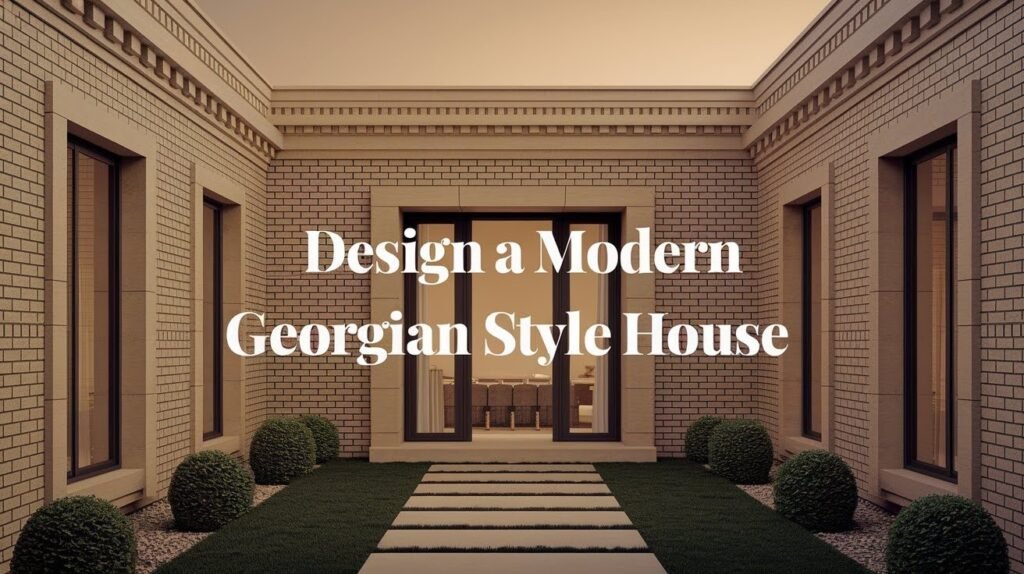Concrete floors have transformed significantly from the cold, industrial surfaces of the past. Today, grey stained concrete floors are gaining popularity in both residential homes and commercial properties for compelling reasons. These smooth surfaces provide exceptional durability, timeless appeal, and remarkable design flexibility. If you’re renovating your living room, garage, patio, or showroom, grey stained concrete delivers a refined, low-maintenance solution that enhances any environment.
This flooring option combines practicality with style, offering homeowners and business owners an attractive alternative to traditional materials. The sophisticated grey tones complement various design schemes while providing the strength needed for high-traffic areas. With minimal upkeep requirements and long-lasting performance, grey stained concrete floors represent a smart investment for those seeking both form and function.
What Are Grey Stained Concrete Floors?
Staining concrete involves applying pigments or chemicals that soak deep into the surface, creating a lasting, vibrant color that won’t chip or peel away. Grey stains have become incredibly popular due to their versatility-they work beautifully whether you’re going for a cool industrial atmosphere or a soft, modern feel.
Acid vs. Water-Based Stains
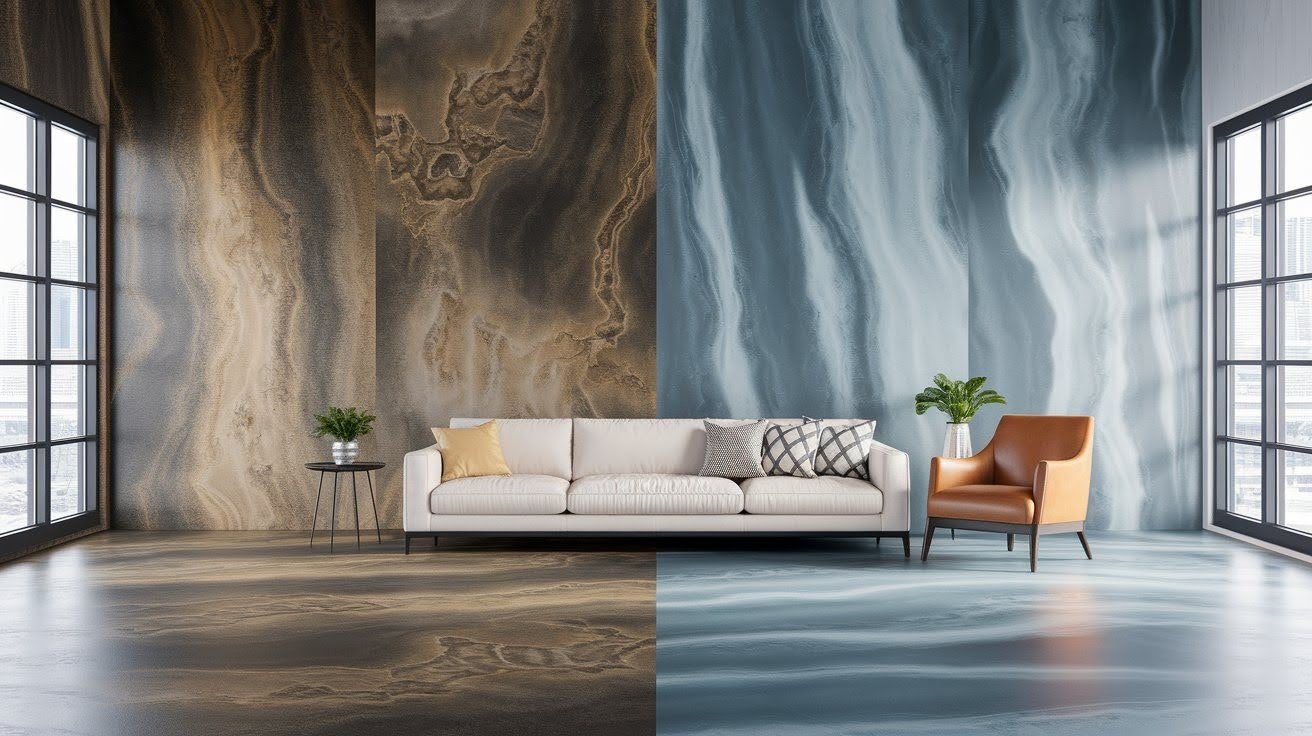
When choosing your grey stain, you’ll encounter two main types:
- Acid-based stains create a chemical reaction with the concrete itself, producing natural variations and marble-like patterns. These work perfectly when you want an organic, rustic appearance with character and depth.
- Water-based stains give you more control over the final result and come in a broader range of colors. If you’re looking for consistent, solid grey tones throughout your space, water-based options are typically your best bet.
Both types penetrate the concrete rather than sitting on top, ensuring your beautiful grey finish will last for years to come.
Installation & Cost: What to Expect
Cost Breakdown
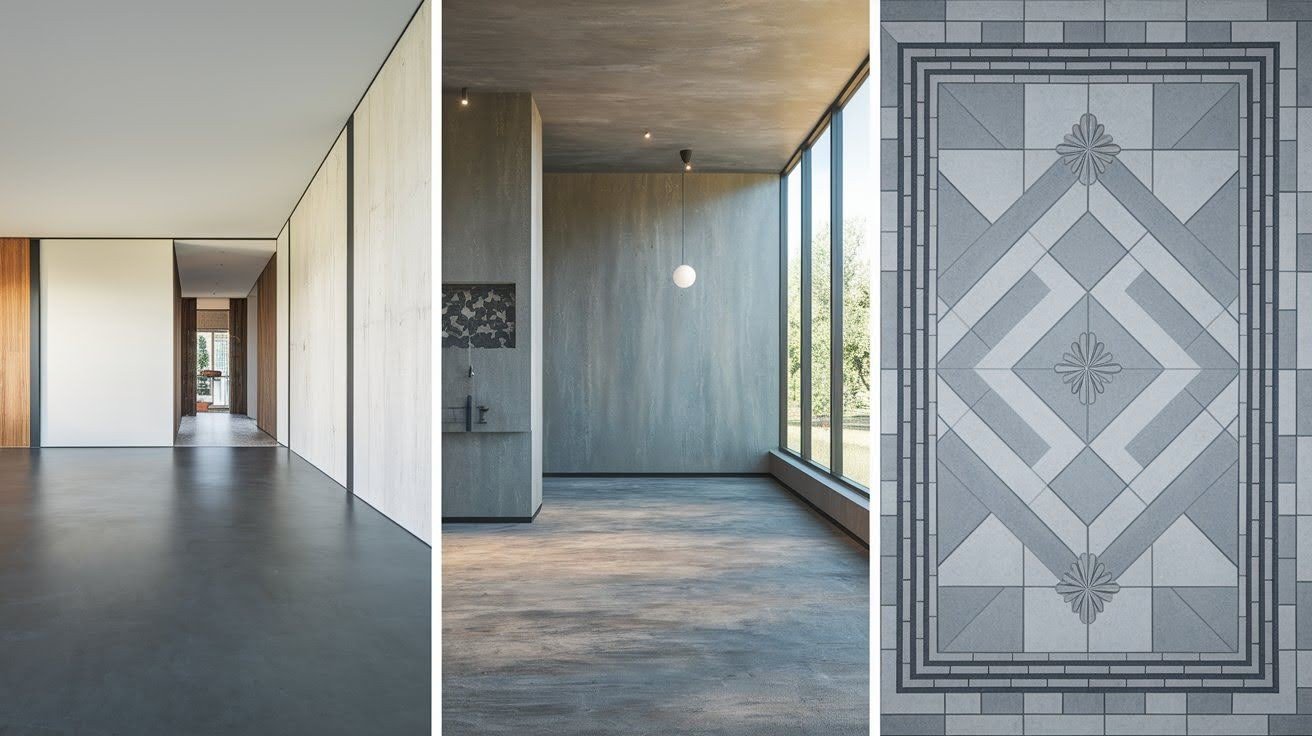
Getting grey stained concrete floors is more affordable than you might think. Here’s what you can expect to pay:
- Basic stain application: $2-$4 per square foot
- Mid-range options with sealer or added texture: $5-$8 per square foot
- Custom designs featuring borders or stencil work: $8-$15 per square foot or higher
Factors That Affect Your Final Price
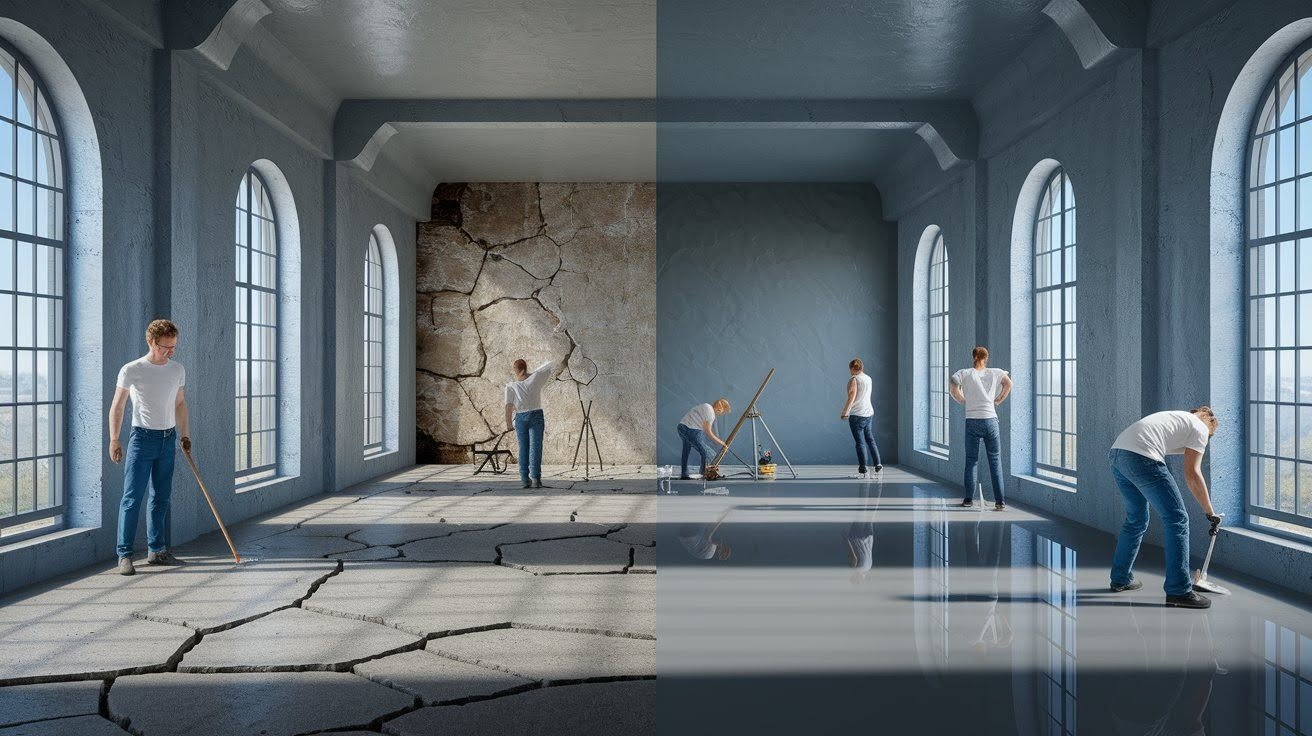
Several elements will influence your total investment:
- The current condition of your existing concrete-newer, smoother surfaces cost less to prepare
- The total square footage you’re covering (larger areas often get better per-square-foot rates)
- Your choice of stain type and finishing products
- Whether you tackle the project yourself or hire professional contractors
Keep in mind that while DIY can save on labor costs, working with experienced professionals often ensures better results and can prevent costly mistakes. The upfront investment pays off through years of beautiful, durable flooring that requires minimal maintenance compared to other options.
Keeping Your Grey Stained Floors Looking Great
Maintaining your grey stained concrete floors is refreshingly simple. Here’s your care routine:
- Daily: A quick sweep or dust mop removes dirt and grit that could scratch the surface over time
- Weekly: Clean with a damp mop using a neutral pH cleaner-avoid harsh chemicals that might damage the stain
- Annually: Apply fresh sealer to high-traffic areas to keep that protective shine and guard against wear
Special Considerations for Outdoor and Garage Spaces
If you’re installing grey stained concrete in your garage, patio, or other outdoor areas, think about adding a slip-resistant topcoat. This extra layer provides better traction when the surface gets wet from rain, snow, or spills. It’s a smart safety feature that doesn’t compromise the beautiful appearance of your floors.
The best part? This maintenance schedule takes just minutes of your time while keeping your floors looking fresh and new for decades. Compare that to refinishing hardwood or replacing worn carpet, and you’ll appreciate how practical this flooring choice really is.
DIY vs. Professional Installation
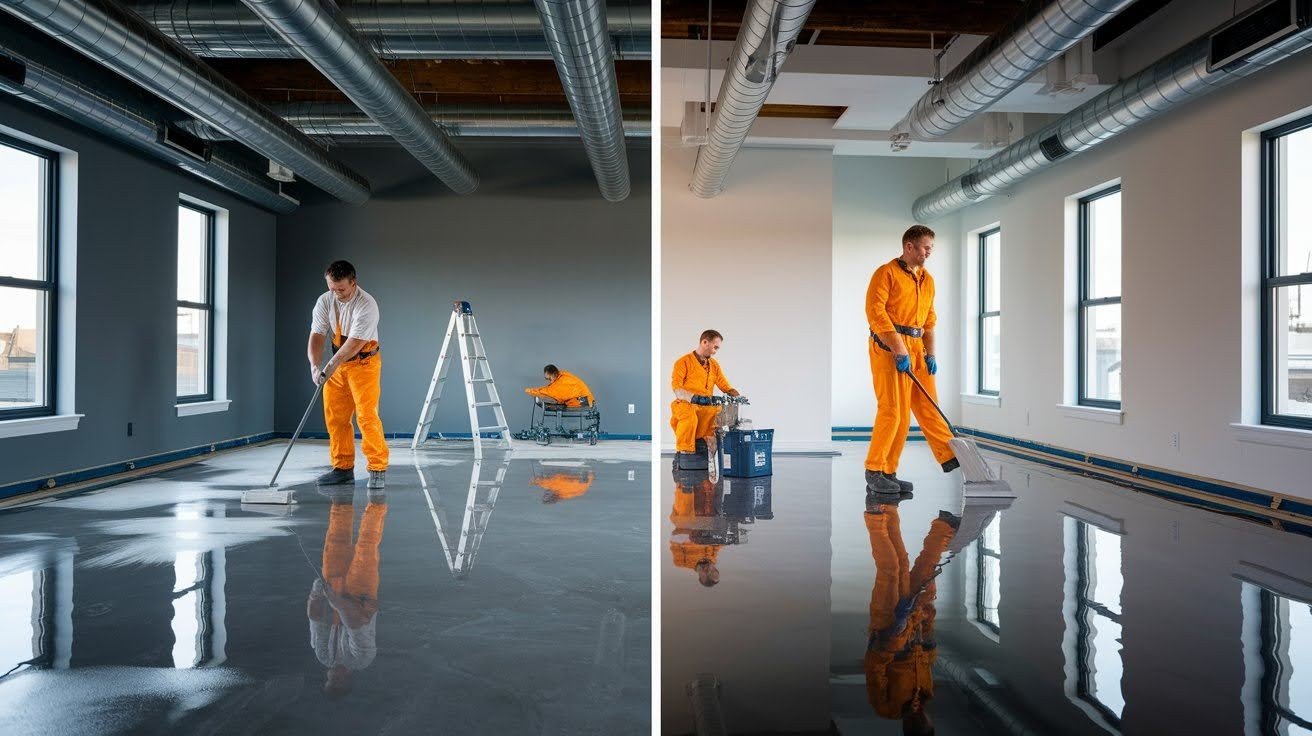
You’ll find plenty of DIY staining kits at your local home improvement store, and while they can work for small projects, bringing in professionals is usually the smarter choice-particularly for larger spaces or when using acid-based stains. Here’s why:
Experienced contractors bring the skills and equipment needed to achieve consistent results across your entire floor. They know exactly how to apply the stain so it penetrates evenly, avoiding those frustrating blotchy spots that can happen with amateur application.
Professional installers also understand the proper techniques for clean, precise work and know how to apply sealers correctly for maximum longevity. This expertise becomes especially valuable when working with acid-based stains, which require careful handling and specific application methods to achieve those beautiful, natural variations safely.
While hiring professionals does increase your upfront costs, the investment typically pays off through superior results that last longer and look better. Plus, you’ll have peace of mind knowing the job was done right the first time, without the stress and potential costly mistakes that can come with tackling such a project yourself.
Where to Use Grey Stained Concrete Floors
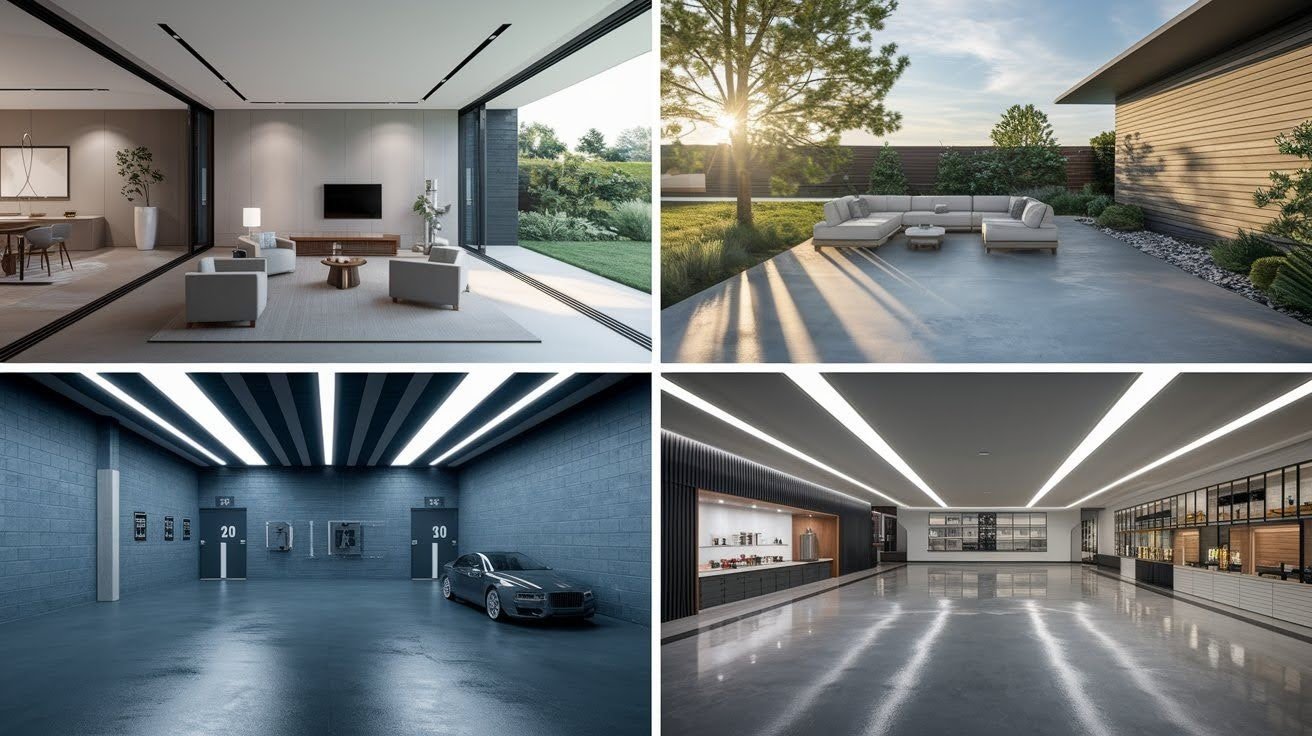
- Residential Interiors Open-concept living spaces, kitchens, and hallways benefit greatly from grey stained concrete. The neutral grey tone provides a grounding foundation that allows furniture and artwork to take center stage without competing for attention.
- Outdoor Patios UV-resistant and weather-resistant properties make stained concrete patios both practical and attractive. These surfaces maintain their sophisticated appearance while withstanding rain, intense heat, and constant foot traffic throughout the seasons.
- Garage Floors Transform boring or stained garage slabs into functional, attractive spaces. Grey-stained concrete can be sealed to provide:
- Chemical resistance against automotive fluids
- Slip-resistance for safety
- Easy cleanup of oil or paint spills
- Commercial Spaces Retail shops, offices, and restaurants find grey stained concrete ideal for their needs. This flooring delivers a modern, polished appearance while proving tough enough to handle heavy daily usage. The professional look appeals to customers while reducing long-term maintenance costs for business owners.
Tips for Grey Stained Concrete Floors
- Test stain colors on a small, hidden area first to see how they react with your specific concrete
- Clean the concrete thoroughly before staining-remove all dirt, grease, and previous coatings
- Allow concrete to cure for at least 28 days before applying stains if it’s newly poured
- Work in manageable sections to maintain consistent application and avoid lap marks
- Use plastic sheeting to protect walls, fixtures, and surrounding areas during application
- Apply stain in thin, even coats rather than trying to achieve full color in one heavy application
Conclusion
Grey stained concrete floors represent far more than a passing design trend-they’re a smart, stylish upgrade that proves its worth year after year. Whether you’re planning to revamp your garage, beautify your patio, or modernize your living space, this flooring option consistently delivers on appearance, durability, and long-term value.
The combination of low maintenance requirements, exceptional longevity, and timeless appeal makes grey stained concrete an investment that pays dividends for decades. From residential homes to commercial spaces, these floors adapt to any environment while providing the strength needed for daily use. With proper installation and minimal care, your grey stained concrete floors will continue looking fresh and contemporary, proving that sometimes the most practical choices are also the most beautiful ones.
Frequently Asked Questions
What are the key features of a modern Georgian style house?
Modern Georgian homes combine classical symmetry with contemporary functionality, featuring balanced window arrangements and refined proportions. Key elements include brick or stone exteriors, multi-pane windows, and central doorways with decorative surrounds.
How do I incorporate modern amenities into Georgian architecture?
Focus on maintaining the exterior’s traditional appearance while updating interior layouts for open-plan living. Install modern systems like smart home technology and energy-efficient windows that complement the classical framework.
What materials work best for a modern Georgian house exterior?
Red brick remains the most authentic choice, though limestone and rendered finishes also work well. Choose high-quality materials that match traditional textures while offering improved insulation and weather resistance.
How should I plan the interior layout of a Georgian-style home?
Create symmetrical room arrangements around a central hallway, maintaining classical proportions while adapting spaces for modern living. Balance formal reception rooms with casual family areas to meet contemporary lifestyle needs.
What color schemes complement modern Georgian architecture?
Neutral palettes work exceptionally well, including cream, white, and soft grey tones for interiors. Exterior colors should emphasize the architectural details, with classic combinations like red brick with white trim or stone with dark accents.


